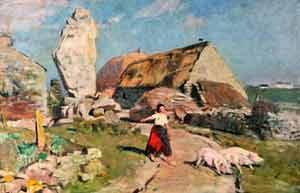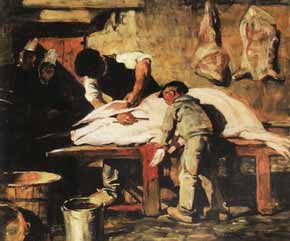France, (1861-1945)

-
Le Menhir de Plozevet
- [The Menhir of Plozevet]
- (ndg.), oil on canvas
- 41.7 x 27.2 in. (106 x 69.00 cm.)
- Private collection
-
Editor’s Note:
A menhir (French, from Middle Breton: maen, “stone” and hir, “long”) is a large upright standing stone also known as an orthostat, megalith or masseba. Menhirs may be found singly as monoliths, or as part of a group of similar stones.
Menhirs are widely distributed across Europe, Africa and Asia, but are most numerous in Western Europe – in particular in Ireland, Great Britain and Brittany. There are about 50,000 megaliths in these areas, with 1,200 menhirs in northwest France alone.

-
La mort du cochon
- [The death of the pig]
- (1922), oil on canvas
- 18.5 x 21.6 in. (47 x 55 cm.)
- Private Collection
-
Editor’s Note:
I would like to thank Grillion http://doudou.gheerbrant.com/blog2/ at her blog on art and life in Brittany for introducing me to Simon and providing some of the information about this work.
About the Artist
Lucien Simon, French, (1861-1945), was associated with the plein air (outdoor) artists who painted around the small towns of Brittany and Northern France. He worked in oils and watercolors with a realist approach, his landscape settings and peasant scenes were intimate, not glamorized or exaggerated.
Simon discovered Brittany in 1890 after marring the portrait painter Jeanne Dauchez, the sister of the painter Andrè Dauchez, and making frequent visits to her parents’ house there. In 1901 he bought a house in Brittany for himself and Jeanne where he lived and worked for the rest of his life.
With Andrè Dauchez, Rene Mènard and Charles Cottet, Simon began a small group of painters characterized by the generally dark tonality of their work. The name ‘La Bande Noire’ (or less often ‘the Nubians’) became associated with the group following the exhibitions at the Salon of 1894 in Paris. [DES-11/15]
